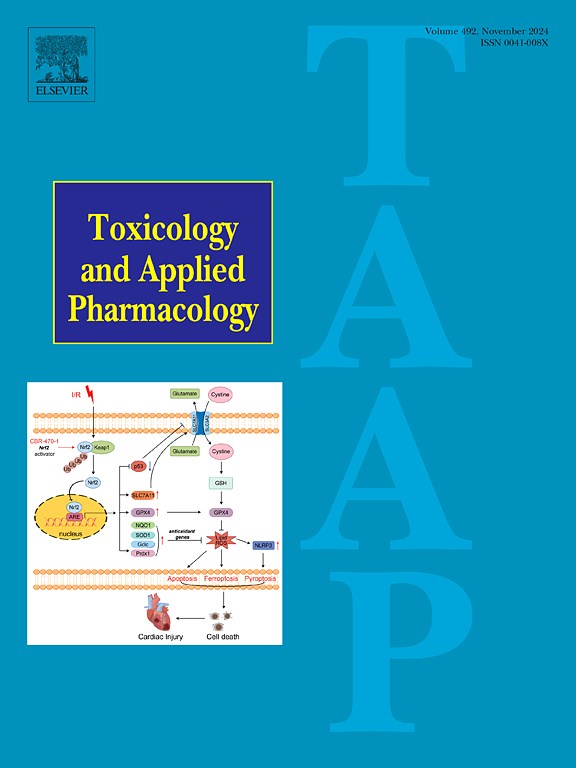Aminooxyacetic acid up-regulates the Cry1 and Bmal1 clock gene in a sirtuin 1 dependent manner. In vitro study
IF 3.3
3区 医学
Q2 PHARMACOLOGY & PHARMACY
引用次数: 0
Abstract
The regulation of the cyclic oscillation of the components of the circadian clock is complex in itself. Numerous clock interactions with processes and molecules present in cells further complicate this mechanism. Recently, the anti-aging protein Silencing Information Regulator Two family member, SIRT1, has been linked with the molecular circadian clock. In this study, we investigated the in vitro effect of aminooxyacetic acid on SIRT1 expression in relation to circadian dynamics of Cry1 and Bma11 expressions in serum shocked NIH-3 T3 and HaCaT cells. The study was carried out in the context of the inhibitory activity of aminooxyacetic acid against cystathionine-β-synthase and cystathionine-γ-lyase. We have shown that aminooxyacetic acid effectively inhibits SIRT1 transcription and synthesis, which, given the pleiotropic effects of sirtuin 1 on numerous metabolic pathways, may have other implications. We also found that AOAA contributes to up-regulation of the expression of the Cry1 and Bmal1 genes in cells. This effect does not appear to be related to inhibition of the activity of cystathionine-β-synthase and cystathionine-γ-lyase. At the same time, this does not deny the role of hydrogen sulphide, a product of the activity of these enzymes, in the regulation of the circadian clock.
氨基乙酸以sirtuin 1依赖的方式上调Cry1和Bmal1时钟基因。体外研究
生物钟组成部分的周期性振荡的调节本身就很复杂。许多时钟与细胞中存在的过程和分子的相互作用使这一机制进一步复杂化。最近,抗衰老蛋白沉默信息调控因子2家族成员SIRT1被发现与分子生物钟有关。在本研究中,我们在体外研究了氨基乙酸对血清休克NIH-3 T3和HaCaT细胞中SIRT1表达与Cry1和Bma11表达昼夜动态的影响。本研究以氨基乙酸对半胱硫氨酸-β-合成酶和半胱硫氨酸-γ-裂解酶的抑制活性为背景进行。我们已经证明,氨基乙酸有效地抑制SIRT1的转录和合成,鉴于sirtuin 1在许多代谢途径中的多效性,这可能具有其他含义。我们还发现,AOAA有助于上调细胞中Cry1和Bmal1基因的表达。这种作用似乎与抑制半胱硫氨酸-β-合成酶和半胱硫氨酸-γ-裂解酶的活性无关。与此同时,这并不否认这些酶的活性产物硫化氢在调节生物钟中的作用。
本文章由计算机程序翻译,如有差异,请以英文原文为准。
求助全文
约1分钟内获得全文
求助全文
来源期刊
CiteScore
6.80
自引率
2.60%
发文量
309
审稿时长
32 days
期刊介绍:
Toxicology and Applied Pharmacology publishes original scientific research of relevance to animals or humans pertaining to the action of chemicals, drugs, or chemically-defined natural products.
Regular articles address mechanistic approaches to physiological, pharmacologic, biochemical, cellular, or molecular understanding of toxicologic/pathologic lesions and to methods used to describe these responses. Safety Science articles address outstanding state-of-the-art preclinical and human translational characterization of drug and chemical safety employing cutting-edge science. Highly significant Regulatory Safety Science articles will also be considered in this category. Papers concerned with alternatives to the use of experimental animals are encouraged.
Short articles report on high impact studies of broad interest to readers of TAAP that would benefit from rapid publication. These articles should contain no more than a combined total of four figures and tables. Authors should include in their cover letter the justification for consideration of their manuscript as a short article.

 求助内容:
求助内容: 应助结果提醒方式:
应助结果提醒方式:


